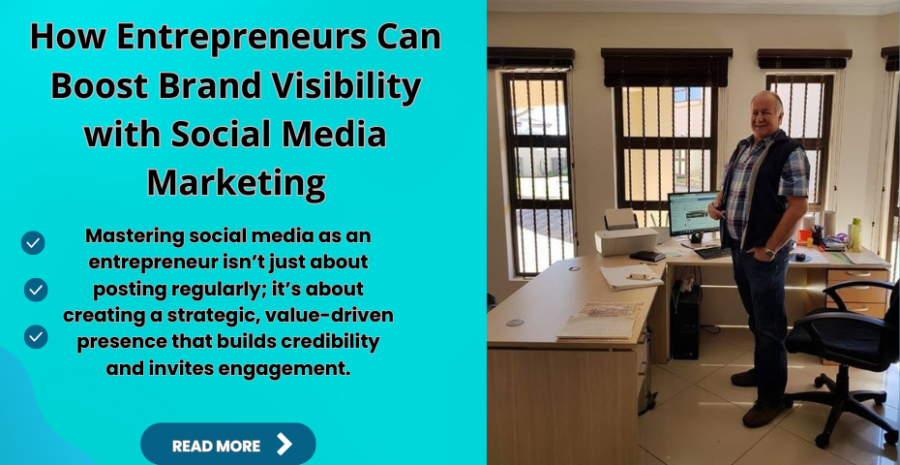
How Entrepreneurs Can Boost Brand Visibility with Social Media Marketing

In today’s digital world, social media is a powerhouse tool that can catapult an entrepreneur’s brand into the spotlight. With billions of users worldwide, platforms like Markethive, Facebook, Instagram, Twitter, LinkedIn, and TikTok allow brands to interact directly with audiences, build relationships, and amplify their messages.
Yet, mastering social media as an entrepreneur isn’t just about posting regularly; it’s about creating a strategic, value-driven presence that builds credibility and invites engagement.
Social media marketing involves understanding your audience, crafting engaging content, leveraging analytics, and keeping pace with rapidly changing algorithms. To grow visibility, entrepreneurs must focus on aligning their brand voice with customer interests and building a community around their brand.
Each social platform has its nuances, meaning an effective social media strategy will adapt based on the audience and platform dynamics. For entrepreneurs, consistency, authentic storytelling, data analysis, and continuous learning are key.
Let’s explore how social media can be a catalyst for entrepreneurial success and break down the essential strategies to boost your brand’s visibility.

The first step in social media marketing is establishing a strong brand identity that stands out in a crowded digital landscape. Your brand voice should align with your values and mission and resonate with your target audience.
Consistency in brand voice and visual aesthetics builds familiarity and recognition, which is crucial for small brands. Use consistent color schemes, typography, and filters to create a visually cohesive feed. Tools like Canva and Adobe Spark can help maintain visual consistency.
Entrepreneurs should also focus on the tone—whether friendly, professional, or inspiring—that best represents their brand.

Not every social media platform will be ideal for every business. Entrepreneurs should carefully select platforms based on their audience demographics and business goals. For instance, Instagram and Pinterest work well for visually-driven brands, Markethive & LinkedIn is valuable for B2B businesses, and TikTok appeals to younger audiences.
Focusing efforts on platforms where the target audience is most active allows entrepreneurs to use resources wisely and achieve higher engagement rates. Analyze competitors’ activity and engage in social listening to make data-driven decisions about platform selection.

A consistent posting schedule builds audience trust and keeps your brand top of mind. A well-thought-out content calendar allows entrepreneurs to plan content that aligns with seasonal trends, product launches, and marketing campaigns.
Plan at least a month in advance and keep room for spontaneous posts to adapt to trends or newsworthy events. Entrepreneurs can use tools like Buffer, Hootsuite, or Later to schedule posts, analyze engagement, and adjust strategies as needed.
Regular posting with a variety of content types—like images, stories, and videos—ensures a fresh, engaging feed.

Engagement is one of the most important factors for social media success. Replying to comments, liking posts, and responding to direct messages can create a positive impression of your brand.
Engage with followers’ content, host Q&A sessions, and run polls to create two-way communication.
Social media algorithms favor accounts that actively engage, so regular interaction can help increase visibility.
By showing genuine interest, entrepreneurs can foster community and loyalty, which leads to better retention and word-of-mouth marketing.

Hashtags are an excellent way for entrepreneurs to increase visibility on platforms like Instagram, Twitter, and LinkedIn and Kiok
Using relevant hashtags makes your posts discoverable to a broader audience and enhances engagement.
However, avoid overusing them; aim for a mix of popular and niche hashtags related to your industry.
For example, an eco-friendly clothing brand might use #sustainablefashion or #ecoclothing to reach environmentally conscious consumers.
Analyze the performance of each hashtag and tweak them periodically to keep your reach optimal.

With the rise of TikTok, Reels, and YouTube Shorts, video content has become crucial for social media success. Videos can demonstrate products, share customer testimonials, and humanize your brand.
Even short videos can engage audiences significantly more than static images.
Entrepreneurs should experiment with different video formats, from how-tos to behind-the-scenes, to see what resonates best with their audience.
Platforms favor video content in their algorithms, so investing time in video creation can be worthwhile.

Influencer marketing can provide an invaluable boost to brand visibility, particularly for startups or lesser-known brands. Collaborating with influencers introduces your brand to a wider audience and lends credibility.
When choosing influencers, ensure they align with your brand values and target demographic. Micro-influencers, in particular, often have more engaged and loyal audiences.
Look at metrics like engagement rate, follower demographics, and past brand collaborations to determine the best fit.

Organic reach can be limiting, especially for newer brands. Paid ads on social media platforms allow entrepreneurs to target specific demographics, interests, and behaviors, maximizing exposure.
Platforms like Markethive, Facebook and Instagram provide detailed analytics to track ad performance and make adjustments. Even a modest budget can yield significant results if the ad is targeted accurately.
Use A/B testing to optimize your ads, and remember that a strong call-to-action can drive conversions.

Consistently reviewing social media metrics is essential for understanding what works and what doesn’t.
Metrics such as engagement rate, reach, impressions, and follower growth provide insights into audience preferences.
Entrepreneurs can leverage platform analytics to optimize future content and refine strategies.
Regular analysis helps ensure your strategy remains effective and allows for timely adjustments if trends or algorithm changes affect performance.

Social media trends are dynamic, and staying updated can help entrepreneurs remain relevant. Regularly researching new features, trends, and best practices ensures that your brand keeps pace with platform changes.
This might include experimenting with AI-powered content, adapting to new content formats, or utilizing platform-specific updates.
Being an early adopter of trends often provides a competitive edge, helping your brand stand out in a crowded space.
Social media marketing, when done right, offers entrepreneurs unprecedented access to audiences and opportunities for brand growth.
By implementing these strategies—defining a unique brand voice, engaging actively with followers, leveraging video, using hashtags, and analyzing performance regularly—entrepreneurs can build a solid social media presence that not only increases visibility but also builds a loyal customer base.
Social media’s power lies in its ability to create meaningful, real-time connections with customers, turning casual viewers into brand advocates.
In a fast-paced, digital-first world, social media marketing has become indispensable for businesses of all sizes. For entrepreneurs, this journey requires adaptability, creativity, and a willingness to engage directly with audiences.
Visibility isn’t just about reaching a wide audience; it’s about leaving an impression and establishing trust. A strong social media presence builds credibility, invites conversation, and helps your brand grow sustainably.
As algorithms evolve and platforms innovate, entrepreneurs who stay flexible and prioritize authenticity will continue to find social media a powerful ally in their journey to brand success.

About: Andries vanTonder
45 years selfemployed
He is a Serial Entrepreneur, an Enthusiastic supporter of Blockchain Technology and a Cryptocurrency Investor
Find me: Markethive Profile Page | My Twitter Account | My Instagram Acount | and my Facebook Profile.
